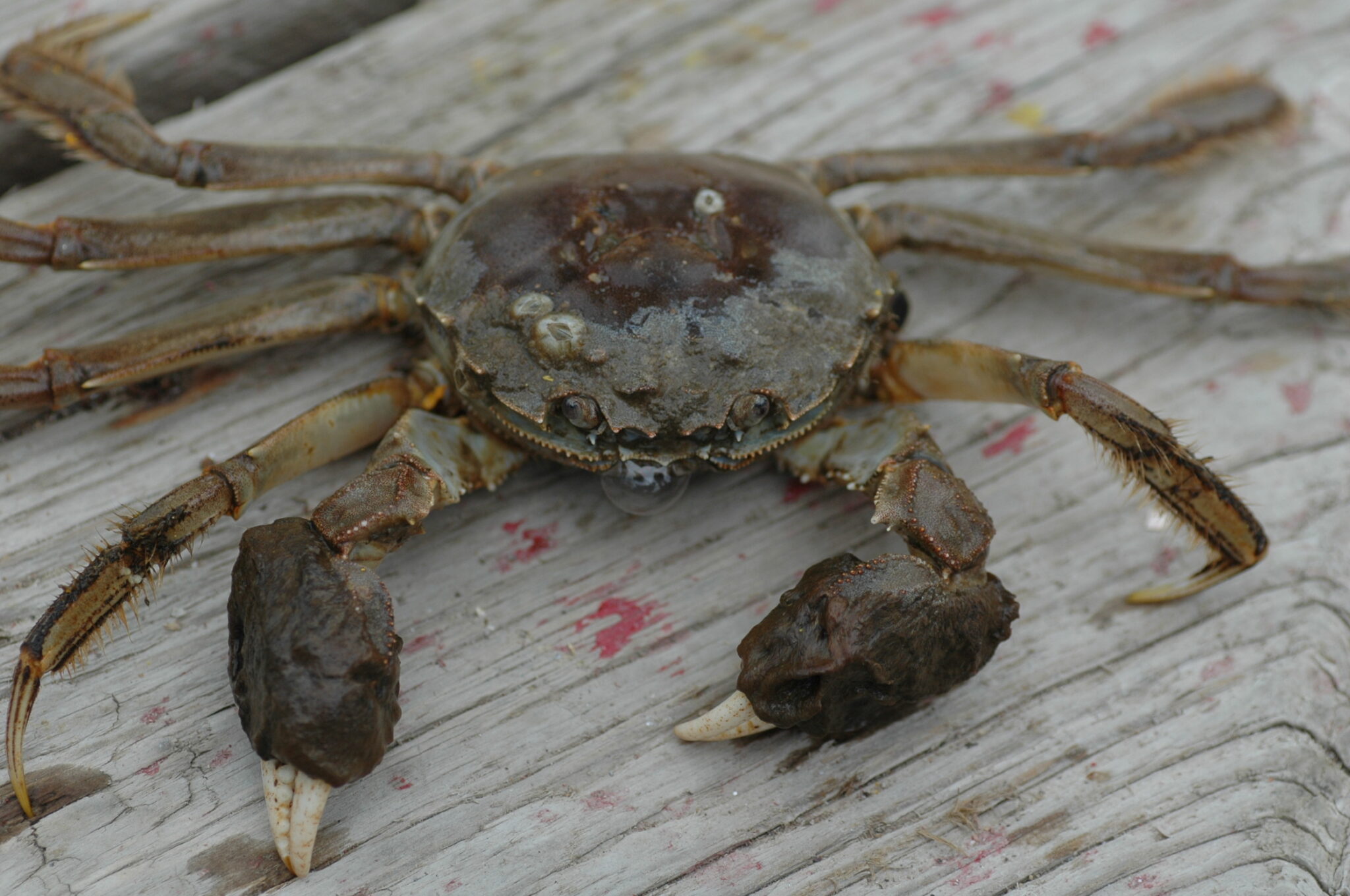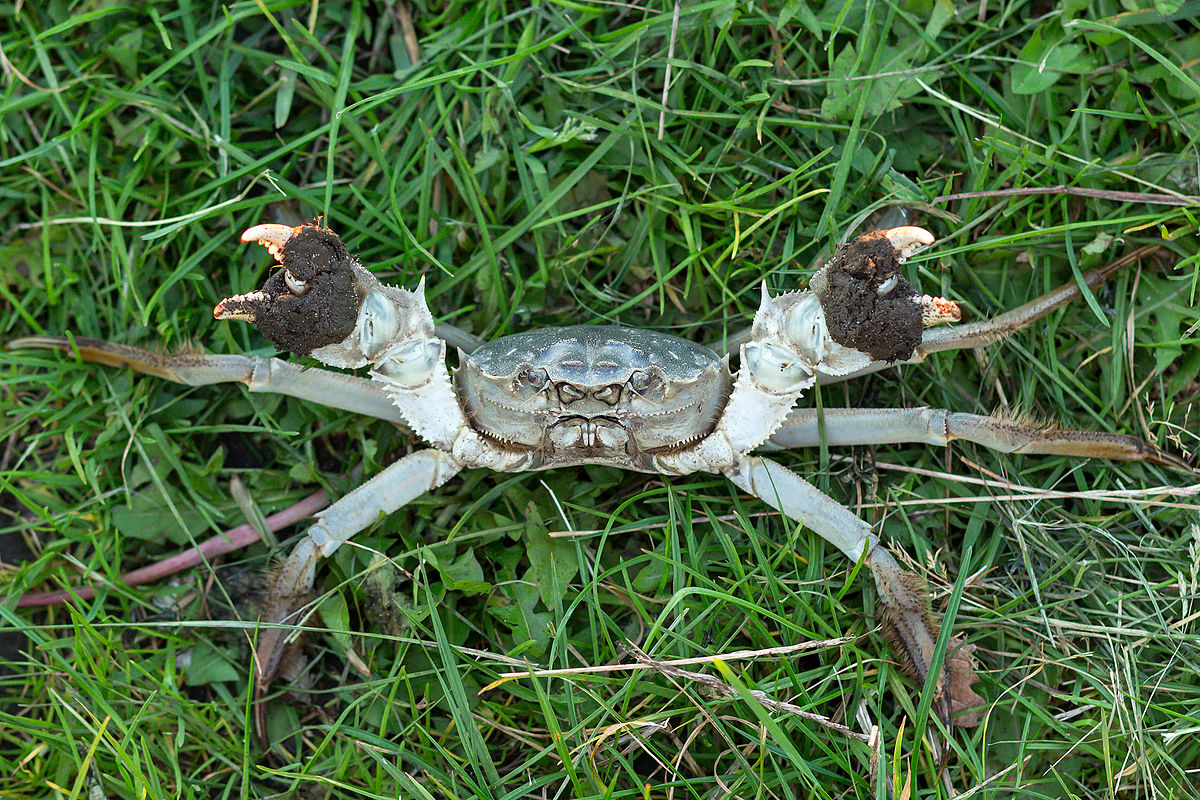Taxonomy and Biology: Chinese Mitten Crab

The Chinese mitten crab, scientifically classified as Eriocheir sinensis, belongs to the family Varunidae within the order Decapoda. It is characterized by its distinctive features and unique life cycle.
Physical Characteristics
The Chinese mitten crab exhibits a robust body with a carapace width ranging from 4 to 12 cm. Its most striking feature is its enlarged and densely hairy chelipeds (claws), which resemble mittens and contribute to its common name. These claws are sexually dimorphic, with males possessing larger and more robust claws than females.
Additionally, the Chinese mitten crab has a dark olive-green or brownish carapace with numerous white or yellowish spots. Its legs are typically a lighter color, often with reddish or orange tips.
Life Cycle and Reproductive Habits
The Chinese mitten crab undergoes a complex life cycle involving several larval stages and a final adult stage. It begins its life as a planktonic larva, drifting in coastal waters for several months. During this time, it undergoes several molts, gradually developing its adult features.
As it matures, the Chinese mitten crab settles on the bottom of estuaries or freshwater habitats. It is a highly migratory species, traveling long distances to find suitable breeding grounds. The crabs reach sexual maturity at around 2-3 years of age. Mating typically occurs in the fall, with females carrying the fertilized eggs on their pleopods (abdominal appendages) until they hatch.
The larvae then disperse into coastal waters, completing the life cycle.
Invasive Species

The Chinese mitten crab, Eriocheir sinensis, has become a significant invasive species in various regions around the world, posing ecological and economic challenges.
The Chinese mitten crab, an invasive species known for its aggressive nature, has become a concern for many ecosystems. However, amidst the discussions surrounding its impact, it’s worth noting the efforts of researchers like James Alexandrou , who have dedicated their work to understanding the biology and behavior of these crabs.
Their insights help us develop effective strategies to mitigate the crab’s ecological footprint, ensuring the health of our aquatic environments.
The introduction of the Chinese mitten crab to non-native regions is primarily attributed to human activities. The species was unintentionally transported through ballast water of ships and aquaculture practices. In the 1990s, it was introduced to Europe through the German Rhine River and rapidly spread throughout the continent.
The Chinese mitten crab, with its voracious appetite, has become a formidable invasive species in many waterways. Meanwhile, across the globe, the rumor mill churns, fueled by the question: is iranian president dead ? Unfounded speculations swirl like the murky waters where the mitten crab thrives, leaving behind a trail of uncertainty and a reminder of the power of misinformation.
The environmental impacts of the Chinese mitten crab’s invasion are multifaceted. It preys on native species, including fish, mollusks, and crustaceans, disrupting the ecological balance. Its burrowing behavior destabilizes riverbanks and dykes, leading to erosion and flooding. Additionally, the crab can transmit parasites and diseases to native species, further threatening their populations.
Economic Impacts
The economic consequences of the Chinese mitten crab’s invasion are also substantial. The crab damages fishing gear, reducing fish catches and impacting the livelihoods of fishermen. It can also clog water intake systems of power plants and irrigation canals, causing costly disruptions. The presence of the crab can also reduce the value of coastal properties and tourism revenue due to its unsightly appearance and potential health hazards.
In the enigmatic waters of Iran’s coastline, where the Persian Gulf whispers tales of ancient empires, the enigmatic Chinese mitten crab thrives. This crustacean voyager, hailing from the distant shores of the East, has embarked on a remarkable journey, navigating the intricate currents of international waterways.
As the sun sets, casting an ethereal glow upon the tranquil waters, a question lingers in the minds of observers: is Iran’s president alive ? The answer, like the elusive crab, remains shrouded in mystery, lost in the depths of diplomatic intrigue.
Yet, amidst the uncertainty, the Chinese mitten crab continues its solitary exploration, a testament to the resilience and adaptability of life in the face of the unknown.
Control Measures
Efforts to control the spread of the Chinese mitten crab have been implemented in various regions. These include physical barriers, such as traps and barriers, to prevent the crab’s movement. Chemical control methods, using pesticides or herbicides, have also been employed but raise concerns about environmental impacts. Biological control, using predators or parasites, has shown promise in some areas but requires further research and implementation.
Culinary Significance
The Chinese mitten crab has gained culinary prominence in various cultures worldwide. Its unique flavor and versatility have made it a delicacy in many cuisines.
Preparation Methods
Chinese mitten crabs are typically steamed, boiled, or stir-fried. Steaming is the most popular method, preserving the crab’s delicate flavor and texture. Boiled crabs are often served with a dipping sauce, while stir-fried crabs are cooked with a variety of ingredients, including ginger, garlic, and soy sauce.
Popular Dishes
In China, Chinese mitten crabs are often served as a main course or appetizer. Steamed crabs are a popular dish during the autumn season, when the crabs are at their peak of flavor. Boiled crabs are often served with a dipping sauce made from vinegar, soy sauce, and ginger. Stir-fried crabs are a popular street food in China, often served with rice or noodles.
Outside of China, Chinese mitten crabs have become popular in Japan, Korea, and other Asian countries. In Japan, they are often used in sushi and sashimi dishes. In Korea, they are used in a variety of soups and stews.
Nutritional Value
Chinese mitten crabs are a good source of protein, vitamins, and minerals. They are low in fat and calories, making them a healthy addition to a balanced diet. The crabs are particularly high in vitamin B12, which is important for the nervous system. They are also a good source of omega-3 fatty acids, which have been shown to have a variety of health benefits, including reducing the risk of heart disease and stroke.
Cultural and Historical Context

The Chinese mitten crab holds significant cultural importance in its native range, China. Its culinary and ecological value has been deeply ingrained in Chinese culture for centuries.
Historically, the Chinese mitten crab has been a highly prized delicacy in traditional Chinese cuisine. Its sweet and savory flesh, coupled with its unique texture, has made it a favorite among food connoisseurs. The crab has been featured in numerous culinary preparations, including steamed, stir-fried, and boiled dishes. Its roe is also considered a delicacy, and is often used as a condiment or filling in various dishes.
Beyond its culinary significance, the Chinese mitten crab also plays a role in Chinese folklore and mythology. In some regions of China, the crab is associated with prosperity and good fortune. It is believed that catching a Chinese mitten crab during the Mid-Autumn Festival brings good luck and wealth. The crab is also featured in various Chinese folk tales and legends, where it is often depicted as a symbol of strength, resilience, and perseverance.
In art and literature, the Chinese mitten crab has been immortalized in paintings, sculptures, and literary works. Chinese artists have long been fascinated by the crab’s unique form and texture, and have depicted it in various forms of art. The crab has also been mentioned in Chinese literature, including poetry, short stories, and novels. Its appearance in these works often serves to symbolize the beauty and bounty of the natural world.
Economic and Ecological Importance
The Chinese mitten crab has significant economic and ecological importance. Its commercial value in the seafood industry is substantial, and it plays a crucial role in marine ecosystems, interacting with various species and influencing the overall balance.
Economic Value, Chinese mitten crab
- The Chinese mitten crab is a highly prized delicacy in many Asian countries, particularly in China and South Korea.
- Its meat is considered flavorful and nutritious, and it is often used in a variety of dishes, including soups, stews, and stir-fries.
- The crab’s large size and high meat yield make it a valuable catch for commercial fisheries, contributing to the livelihoods of many fishermen.
Ecological Role
In its native habitat, the Chinese mitten crab plays a vital role in the marine ecosystem.
- As a scavenger, it helps to clean up the environment by consuming dead and decaying organic matter.
- It is also a predator, feeding on a variety of invertebrates, including mollusks, worms, and small fish.
- Its burrowing behavior can help to aerate the sediment and improve water quality.
Conservation Measures
Due to its economic and ecological importance, conservation measures have been implemented to protect the Chinese mitten crab populations.
- In some areas, fishing quotas have been established to prevent overfishing.
- Habitat restoration projects have been undertaken to improve the crab’s breeding and feeding grounds.
- Research is ongoing to better understand the crab’s biology and ecology, which will inform future conservation efforts.